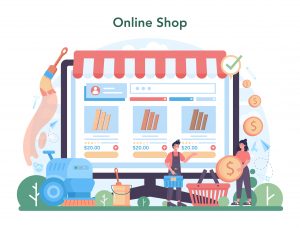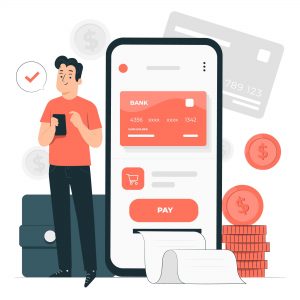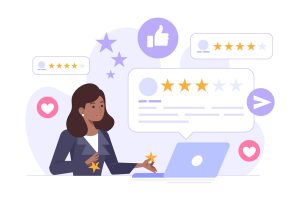Welcome to our website blog! Your one-stop destination for learning how to build exceptional e-commerce websites. If you’re interested in improving your internet presence and expanding your business’s potential, you’re in for a treat.
A fascinating and perfectly working e-commerce website is the key to attracting and pleasing clients in today’s fast-paced digital landscape. With our blog, we hope to provide you with tips, tricks, and hacks that will help you take your e-commerce website to the next level.
Ready to dive in? We’ll guide you through the complexity of user experience design, helping your e-commerce websites to captivate visitors. Discover the art of intuitive navigation, visually appealing interfaces, and persuasive calls-to-action that drive conversions and leave a lasting impression.
What is an E-Commerce website?
According to strikingly.com E-commerce or electronic commerce refers to a business model that involves sales transactions being done on the web. Virtually every online shopping website – big or small – follows this structure. Any site where you can obtain items for sale over the internet is considered e-commerce.
So when did E-commerce was established?
- According to healthcaremba.gwu.edu, the first online marketplace, Boston Computer Exchange, was in 1982, opens for business.
- And in 1995 — Influential e-commerce marketplaces Amazon and eBay launched. Both companies complete one million transactions by 1997.
Key E-Commerce Facts and Statistics

According to oberlo.com Data from the US Department of Commerce shows that US e-commerce sales have been growing steadily for over a decade, with significant growth in the previous three years.
In 2022, total US e-commerce sales hit a record high of $1.04 trillion, after recording an 8.5% annual increase. Despite the annual growth rate being less than half of the previous year’s and the slowest in at least a decade, the rise was able to push it over the $1 trillion mark. This is an impressive increase from a decade ago in 2013 when online sales in the US totaled $260.4 billion.
Your website serves as the face of your brand, the portal to your products and services, and the platform through which you communicate with your clients. We’ve compiled a list of helpful tips and hacks to help you create amazing e-commerce websites that stand out from everyone else.
1.) An Advance Intuitive UX
According to bigcommerce.com, when it comes to UX and site design, there are key areas to focus on.
Mobile optimization is non-negotiable by today’s standards. With customers using multiple devices throughout each path to purchase, ensuring they can do what they came to your site to do, regardless of the device used, is a must. Optimizing your e-commerce site for mobile can cause a massive spike in sales and conversions.
An intuitive site architecture is critical for guaranteeing that your visitors can easily navigate your site. This involves strategically organizing your product catalog and related product pages, as well as making other portions of your site accessible as well.
2.) Build Great Product Pages

The most effective product pages will find a balance between presenting all of the information potential customers need about the product and ultimately encouraging them to make a purchase – without overwhelming them with information.
Product visuals consisting of high-quality photos, as well as explainer videos on your product, are excellent ways to engage a potential customer’s senses. Consider using lifestyle and textural imagery, as well as visuals of your customers using your product, to help potential consumers visualize how your product may benefit them.
Carousel, coz why not?
According to loop-digital.co.uk, while marketers may not agree on the value of image and video carousels on the homepage, you will find many e-commerce brands use them.
Major retailers such as Walmart, eBay, Home Depot, Samsung, Wayfair, Lowes, Costco, Sam’s Club, and Kohls’s have carousels with their latest promotions and sales.
Carousels can adapt to different screen sizes and devices, making them suitable for mobile e-commerce. With the growing number of users accessing websites on mobile devices, having a responsive carousel ensures a seamless and visually pleasing experience across various platforms.
It is also an effective way to showcase new arrivals, seasonal promotions, or limited-time offers. By featuring these prominently in the carousel, you can draw attention to these items and generate interest and excitement among your customers.
3.) Reduce Your Page Loading Speed
According to beeketing.com, a long page loading speed can drive away impatient shoppers. According to a study, the pages that took about 1.5 seconds to load, had a bounce rate of 38.24%. On the other hand, the bounce rate was 44.28% for pages that took longer than 3 seconds to load. The key takeaway is pretty clear — Don’t make your site visitors wait. What can you do to reduce your page loading speed?
First, find out how your site currently fares concerning page loading speed. Go to Google PageSpeed Insights and enter your website URL. This way, you’ll be able to get your current page loading speed. Using this tool, you can check the page loading speed for both mobile as well as desktop devices. Furthermore, they also provide suggestions on how to improve your site speed.
4.) Incorporate Chatbots in your E-commerce Website
 Chatbots can be a valuable asset in improving your entire customer experience. You can use them to respond to client inquiries, provide product recommendations, and even connect customers to customer support representatives.
Chatbots can be a valuable asset in improving your entire customer experience. You can use them to respond to client inquiries, provide product recommendations, and even connect customers to customer support representatives.
Advanced chatbots can analyze customer preferences, purchase history, and browsing behavior to provide personalized product recommendations. By understanding customer preferences, chatbots can suggest relevant products, increasing cross-selling and upselling opportunities.
It can also handle a wide range of frequently asked questions, such as return policies, sizing inquiries, and FAQs about specific products or services. By addressing these queries, chatbots reduce the burden on customer support teams and improve efficiency.
5.) Provide Multiple Options for Payment

According to beeketing.com, payment Credit and debit cards are certainly popular online payment methods. However, don’t presume that everyone who wants to buy from your business will use them. What if they only want to pay in cash once the item has been delivered? What if they’d rather use PayPal?
You must consider various preferences and give multiple payment choices. If someone is looking for cash on delivery and you do not provide it, they may abandon their cart. Due to a lack of options, you may lose potential customers. To avoid this, provide a variety of payment alternatives on your e-commerce website.
6.) Simplify Check- out Process

After a prospect decides to make a purchase, how much effort do they need to put in before they can complete the checkout process?
Some prospects might just leave the process mid-way because they are exhausted or distracted.
To avoid this, make the checkout process as simple and convenient as possible. Ask prospects to enter only the information that you need. Name, address, and payment details — these details should be more than enough to complete the purchase.
7.) Display Customer Reviews
 Displaying customer reviews prominently on an e-commerce website is essential for several reasons.
Displaying customer reviews prominently on an e-commerce website is essential for several reasons.
a.) Building Trust and Credibility
Customer reviews serve as social proof, demonstrating that your products or services have been tried and appreciated by real customers. Positive reviews build trust and credibility, reassuring potential buyers that they are making a reliable and informed purchase decision.
b.) Influencing Purchase Decisions
Reviews have a significant impact on consumer behavior. Many shoppers actively seek out reviews before making a purchase, as they rely on the experiences and opinions of others to gauge the quality and suitability of a product. By prominently displaying reviews, you provide valuable information that influences and validates purchase decisions.
c.) Managing Customer Expectations
Displaying a range of reviews, including both positive and critical feedback, helps manage customer expectations. Honest and transparent reviews provide a realistic understanding of the product, its features, and any limitations. This reduces the likelihood of customers feeling disappointed or misled after making a purchase.
8.) Optimize Your Website Navigation Structure
Optimizing your e-commerce website navigation structure is crucial for providing a seamless and user-friendly browsing experience. Here are the key reasons why it is important:
a.) Enhances User Experience
A well-optimized navigation structure ensures that visitors can easily find the information they need and navigate through your website effortlessly. Intuitive navigation reduces frustration, improves user satisfaction, and encourages visitors to explore more pages, increasing the chances of conversions and repeat visits.
b.) Facilitates Easy Product Discovery
An optimized navigation structure helps users quickly locate and browse through your product catalog. Clear and logical categories, subcategories, and filters make it easier for visitors to find the specific products they are interested in. This streamlined process improves the chances of users discovering products they might not have otherwise come across.
c.) Reduces Bounce Rates
When visitors can’t find what they are looking for or encounter a confusing navigation structure, they are more likely to leave your website without taking any action. Optimized navigation helps minimize bounce rates by providing clear pathways and guiding visitors to relevant content, reducing the likelihood of exits.
9.) Website Security

According to loop-digital. co, an e-commerce site should provide a safe place to store and process online transactions. Retail giants like Amazon and eBay have over time gained the trust of buyers through their proven security measures.
According to a study in 2018, the e-commerce industry experienced up to 32% of all successful security threats annually. It’s crucial that you implement several protocols to safeguard your buyers online. For customers to complete transactions and share their private information, they need to know that they can trust your business and your website.
Visual trust signals on your homepage and throughout your site, instill that needed trust value, without which your customers might consider spending their hard-earned cash elsewhere! Having a secure payment system is paramount, and resilience to hackers and malware is key.
Conclusion
In conclusion, implementing the right tips and hacks for better e-commerce website development can significantly enhance your online business’s success. By focusing on optimizing various aspects of your website, from design and functionality to user experience and conversion strategies, you can create a compelling online shopping destination for your customers.
References
• How To Create a Customer Oriented E-commerce Website
• E-commerce Customer Experience
• What makes a Good E-commerce Website


